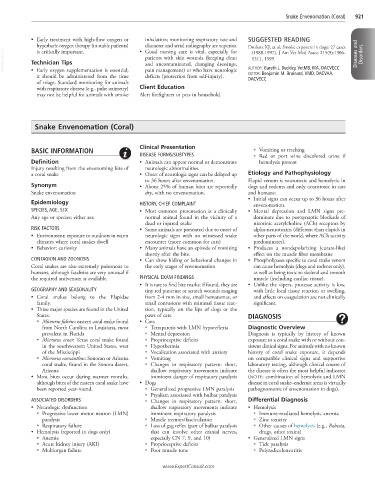Page 1837 - Cote clinical veterinary advisor dogs and cats 4th
P. 1837
Snake Envenomation (Coral) 921
• Early treatment with high-flow oxygen or inhalation; monitoring respiratory rate and SUGGESTED READING
hyperbaric oxygen therapy (in stable patients) • Good nursing care is vital, especially for Drobatz KJ, et al: Smoke exposure in dogs: 27 cases
character and serial radiography are superior.
VetBooks.ir Technician Tips patients with skin wounds (keeping clean AUTHOR: Gareth J. Buckley, VetMB, MA, DACVECC Diseases and Disorders
is critically important.
(1988-1997). J Am Vet Med Assoc 215(9):1306-
1311, 1999.
and uncontaminated, changing dressings,
• Early oxygen supplementation is essential;
deficits (protection from self-injury).
it should be administered from the time pain management) or who have neurologic EDITOR: Benjamin M. Brainard, VMD, DACVAA,
DACVECC
of triage. Standard monitoring for animals
with respiratory distress (e.g., pulse oximetry) Client Education
may not be helpful for animals with smoke Alert firefighters to pets in household.
Snake Envenomation (Coral)
Clinical Presentation
BASIC INFORMATION ○ Vomiting or retching
DISEASE FORMS/SUBTYPES ○ Red or port wine discolored urine if
Definition • Animals can appear normal or demonstrate hemolysis present
Injury resulting from the envenoming bite of neurologic abnormalities.
a coral snake • Onset of neurologic signs can be delayed up Etiology and Pathophysiology
to 36 hours after envenomation. Elapid venom is neurotoxic and hemolytic in
Synonym • About 25% of human bites are reportedly dogs and rodents and only neurotoxic in cats
Snake envenomation dry, with no envenomation. and humans:
• Initial signs can occur up to 36 hours after
Epidemiology HISTORY, CHIEF COMPLAINT envenomation.
SPECIES, AGE, SEX • Most common presentation is a clinically • Mental depression and LMN signs pre-
Any age or species; either sex normal animal found in the vicinity of a dominate due to postsynaptic blockade of
dead or injured snake nicotinic acetylcholine (ACh) receptors by
RISK FACTORS • Some animals are presented due to onset of alpha-neurotoxins (different than elapids in
• Environment: exposure to outdoors in warm neurologic signs with no witnessed snake other parts of the world, where ACh activity
climates where coral snakes dwell encounter (more common for cats) predominates).
• Behavior: curiosity • Many animals have an episode of vomiting • Produces a nondepolarizing (curare-like)
shortly after the bite. effect on the muscle fiber membrane
CONTAGION AND ZOONOSIS • Can show hiding or behavioral changes in • Phospholipases specific to coral snake venom
Coral snakes are also extremely poisonous to the early stages of envenomation can cause hemolysis (dogs and rodents only),
humans, although fatalities are very unusual if as well as being toxic to skeletal and smooth
the required antivenom is available. PHYSICAL EXAM FINDINGS muscle (including cardiac tissue).
• It is rare to find bite marks; if found, they are • Unlike the vipers, protease activity is low,
GEOGRAPHY AND SEASONALITY tiny red puncture or scratch wounds ranging with little local tissue reaction or swelling,
• Coral snakes belong to the Elapidae from 2-4 mm in size, small hematomas, or and effects on coagulation are not clinically
family. small contusions with minimal tissue reac- significant.
• Three major species are found in the United tion, typically on the lips of dogs or the
States. paws of cats. DIAGNOSIS
○ Micrurus fulvius: eastern coral snake found • Cats
from North Carolina to Louisiana, most ○ Tetraparesis with LMN hyporeflexia Diagnostic Overview
prevalent in Florida ○ Mental depression Diagnosis is typically by history of known
○ Micrurus tener: Texas coral snake found ○ Proprioceptive deficits exposure to a coral snake with or without con-
in the southwestern United States, west ○ Hypothermia sistent clinical signs. For animals with no known
of the Mississippi ○ Vocalization associated with anxiety history of coral snake exposure, it depends
○ Micrurus eurxanthus: Sonoran or Arizona ○ Vomiting on compatible clinical signs and supportive
coral snake, found in the Sonora desert, ○ Changes in respiratory pattern: short, laboratory testing, although clinical course of
Arizona shallow respiratory movements indicate the disease is often the most helpful indicator
• Most bites occur during warmer months, imminent danger of respiratory paralysis (NOTE: combination of hemolysis and LMN
although bites of the eastern coral snake have • Dogs disease in coral snake–endemic areas is virtually
been reported year-round. ○ Generalized progressive LMN paralysis pathognomonic of envenomation in dogs).
○ Ptyalism associated with bulbar paralysis
ASSOCIATED DISORDERS ○ Changes in respiratory pattern: short, Differential Diagnosis
• Neurologic dysfunction shallow respiratory movements indicate • Hemolysis
○ Progressive lower motor neuron (LMN) imminent respiratory paralysis ○ Immune-mediated hemolytic anemia
paralysis ○ Muscle tremors/fasciculation ○ Zinc toxicity
○ Respiratory failure ○ Loss of gag reflex (part of bulbar paralysis ○ Other causes of hemolysis (e.g., Babesia,
• Hemolysis (reported in dogs only) that can involve other cranial nerves, drugs, other toxins)
○ Anemia especially CN 7, 9, and 10) • Generalized LMN signs
○ Acute kidney injury (AKI) ○ Proprioceptive deficits ○ Tick paralysis
○ Multiorgan failure ○ Poor muscle tone ○ Polyradiculoneuritis
www.ExpertConsult.com

